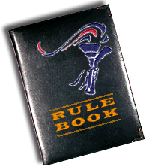The Rules
The leadership election is organised by the Chairman of the backbench
Conservative 1922 Committee, Archie Hamilton, who was elected on May 21.
There had been some debate about whether to allow party members a greater role
in the election of party leader - the Chairman of the National Union (the
voluntary side of the party) and Party Chairman Brian Mawhinney said grassroots activists should be
involved directly with up to 20 per cent of the vote in an electoral college.
However, the 1922 Committee decided that the next leader should be elected
under the existing rules by the 164 Conservative
MPs.
How many supporters does a candidate need in order to stand? Just 2 -
the minimum needed is the backing of a proposer and a seconder (both of whom
must be MPs).
Who can vote? The rules say all MPs in receipt of the Conservative whip
can vote. In the last leadership election in 1995,
the then Chairman of the 1922 Committee, Sir Marcus Fox, also ruled that two
Conservative MPs not in receipt of the Whip - Dame Janet Fookes (Deputy
Speaker) and Michael Morris (Chairman of Ways and Means) could vote if they
wished.
The Chairman of the 1922 Committee will again presumably have discretion over
whether Alan Haselhurst (Chairman of Ways and
Means) and Michael Lord (Deputy Chairman of Ways
and Means) are entitled to vote.
What if an MP is unable to vote in person? If an MP is "unavoidably
absent" from the House of Commons on the day of the ballot, the Chairman of the
1922 Committee can make arrangements for a proxy
vote.
So it's just the MPs' decision? Well, the MPs are the only ones
currently entitled to vote, but the rules say there should be consultation. The
officers of the 1922 Committee are informed of the views of Conservative peers,
MEPs and constituency activists. MPs can then consult the Committee to find out
what the wider party thinks. MPs are also required to canvass the views of
their respective associations.
OK, but how does the voting work? It's organised in a series of ballots
- the first of which is on June 10. Candidates can win on the first ballot, but
need to have an overall majority of the votes of all those entitled to vote (83
votes given the Conservative Parliamentary Party's current size), and have a
lead over the second-placed candidate of at least 15% of the votes of all those
entitled to votes (ie 25 votes).
What if nobody meets that? If no candidate in the first ballot wins 83
or more votes, or wins more than that but fails to lead by at least 25 votes,
then there must be a second ballot a week later on June 17. Candidates who
want to remain in the second ballot must re-enter their nomination.
How many votes do you need to win on the second round? An overall
majority of the votes of all those entitled to vote (ie 83 votes).
And if nobody gets that? If no candidate receives 83 votes, the two
candidates who wish to remain in the race and won the highest number of votes
in the second round go forward to a third ballot two days later on June 19.
Then on the third round? The candidate winning a majority of the votes
cast will be elected. Should the result be a tie, and in the event that the
candidates are unable to resolve the matter between themselves, a fourth ballot
shall be held on the following Tuesday - June 24.
So the winner then becomes party leader? Yes, but they do have to attend
a meeting of MPs, peers, MEPs and the Executive Committee of the National Union
where they'll be approved by acclamation.
|

